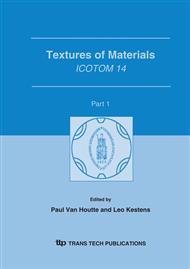[1]
Van Houtte P, Mols K, Van Bael B, Aernoudt E, Textures and Microstructures 1989, 11: 23.
DOI: 10.1155/tsm.11.23
Google Scholar
[2]
Hosford W F, The Mechan. Crystals and Textured Polycrystals, Oxford University Press (1993).
Google Scholar
[3]
Bacroix B, Gilormini P, Model. Simul. Mater. Sci. Eng. 1995, 3: 1.
Google Scholar
[4]
Balasubramanian S, Anand L, Computational Mechanics 1996, 17: 209.
Google Scholar
[5]
Hosford W F, Textures and Microstructures 1996, 26: 479.
Google Scholar
[6]
Kocks U F, Tóme C N, Wenk H R, Texture and Anisotropy - Preferred Orientations in Polycrystals and Their Effect on Material Properties, Cambridge University Press (1998).
Google Scholar
[7]
Zhou Y, Jonas J J, Savoie J, Makinde A, MacEwen S R, Intern. J. Plasticity 1998, 14: 117.
Google Scholar
[8]
Hu, J G, Jonas J J, Ishikawa T, Mater. Sc. Engin. A 1998, 256: 51.
Google Scholar
[9]
Aretz H, Luce R, Wolske M, Kopp R, Goerdeler M, Marx V, Pomana G, Gottstein G, Model. Simul. Mater. Sci. Eng. 2000, 8: 881.
DOI: 10.1088/0965-0393/8/6/309
Google Scholar
[10]
Peeters B, Hoferlin E, Van Houtte P, Aernoudt E, Intern. J. Plasticity 2001, 17: 819.
Google Scholar
[11]
Becker R, Smelser R E, Panchanadeeswaran S, Modelling Simul Mater Sci Eng 1993, 1: 203.
Google Scholar
[12]
Beaudoin A J, Dawson P R, Mathur K K, Kocks U K, Korzekwa D A. Comput Methods Appl Mech Engrg 1994, 117: 49.
Google Scholar
[13]
Engler O, Kalz S, Mater. Sc. Engin. A 2004, 373: 350.
Google Scholar
[14]
Chung Y H, Cho K K, Han J H, Shin M C, Scripta Mater. 2000, 43: 759.
Google Scholar
[15]
Savoie J, Zhou Y, Jonas J J, MacEwen S R, 1996 Acta Mater., 44: 587.
Google Scholar
[16]
Zhao Z, Mao W, Roters F, Raabe D: Acta Mater. 2004, 52: 1003.
Google Scholar
[17]
Wassermann G, Grewen J, Texturen metall. Werkstoffe, Springer-Verlag, Germany (1969).
Google Scholar
[18]
Mishra S, Därmann C, Lücke K, Acta Met. 1984, 32: 2185.
Google Scholar
[19]
Hutchinson W B, Int. Mat. Rev. 1984, 29: 25.
Google Scholar
[20]
von Schlippenbach U, Emren F, Lücke K, Acta Metall. 1986, 34: 1289.
Google Scholar
[21]
Ray R, Jonas J, Mat. Rev. 1990, 35: 1.
Google Scholar
[22]
Hölscher M, Raabe D, Lücke K, Steel Research 1991, 62: 567.
Google Scholar
[23]
Raabe D, Lücke K, Mater. Sc. Techn. 1993, 9: 302.
Google Scholar
[24]
Hill R. Proc Royal Soc London 1948, A193: 281.
Google Scholar
[25]
Hill R. Math Proc Cambridge Philos Soc 1949, 85: 179.
Google Scholar
[26]
Hosford W F, Seventh N, American Metalworking Res. Conf. Proc, 1979: 191.
Google Scholar
[27]
Barlat F, Mater. Sc. Engin. 1987, 91: 55.
Google Scholar
[28]
Barlat F, Lian J., Int. Intern. J. Plasticity 1989, 5: 51.
Google Scholar
[29]
Pierce D, Asaro R J, Needleman A, Acta Metall. 1982, 30: 1087.
Google Scholar
[30]
Asaro R J, Adv. appl. Mech. 1983, 23: 1.
Google Scholar
[31]
Pierce D, Asaro R J, Needleman A, Acta Metall. 1983, 31: (1951).
Google Scholar
[32]
Needleman A, Asaro R J, Acta Metall. 1985, 33: 923.
Google Scholar
[33]
Kalidindi S R, Bronkhorst C A, Anand L, J. Mech. Phys. Solids 1992, 40: 537.
Google Scholar
[34]
Mathur K K, Dawson P R, Intern. J. Plasticity 1989, 5: 67.
Google Scholar
[35]
Smelser R E, Becker R. ABAQUS User's Group Conf. Proc., Oxford 1999: 457.
Google Scholar
[36]
Beaudoin A J, Dawson P R, Mathur K K, Kocks U F, Korzekwa D A. Comp Meth Appl Mech Eng 1994, 117: 49.
Google Scholar
[37]
Raabe D, Roters F, Intern. J. Plasticity 2004, 20: 339.
Google Scholar
[38]
Raabe D, Zhao Z, Roters F, Scripta Mater. 2004, 50: 1085.
Google Scholar
[39]
Li S, Hoferlin E, Van Bael A, Van Houtte P, Adv. Engin. Mater. 2001, 3: 990.
Google Scholar
[40]
Nakamachi E, Xie C L, Harimoto M, Intern. J. Mechan. Sc. 2001, 43: 631.
Google Scholar
[41]
Xie C L, Nakamachi E, Materials and Design 2002, 23: 59.
Google Scholar
[42]
MSC. Marc user's manual, Vol. D, MSC Software Corporation, (2001).
Google Scholar
[43]
Raabe D, Sachtleber M, Zhao Z, Roters F, Zaefferer S, Acta Mater. 2001, 49: 3433.
Google Scholar
[44]
Wang Y, Raabe D, Klüber C, Roters F, Acta Mater. 2004, 52: 2229.
Google Scholar
[45]
Raabe D, Steel Research 1995, 66: 222.
Google Scholar
[46]
Raabe D, Scripta metall. 1995, 33: 735.
Google Scholar
[47]
Bunge H J, 1982 Texture analysis in materials science. Butterworths, London, England.
Google Scholar


